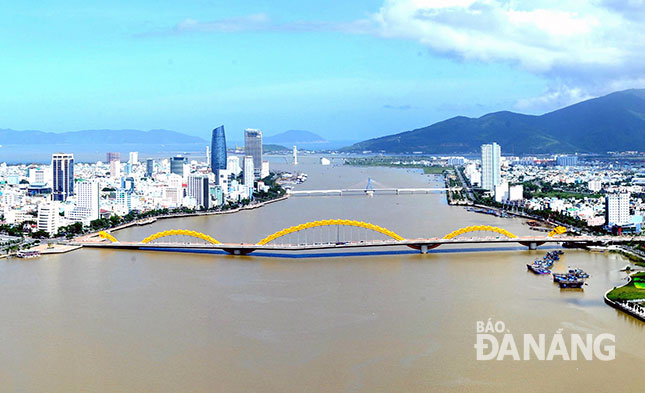City sets development targets by 2030, vision towards 2025
Da Nang aims to see the gross regional domestic product (GRDP) growth of 9 - 11%, and GRDP per capita ranging between 7,000 USD and 9,000 USD for the 2018 - 2030 period.
 |
| The city’s urban space should be developed based on the great potential of the Han River |
The figures were released at a workshop held by the municipal People’s Committee on Monday to discuss the master plan for the city’s progress by 2030 with a vision towards 2045.
In attendance at the event were municipal Party Committee Deputy Secretary Vo Cong Tri, municipal People’s Committee Vice Chairman Ho Ky Minh, other city leaders, and urban planners, economists and policy makers from both at home and abroad.
Under the master plan, Da Nang strives to become a green, modern-smart, global city with unique identity.
In more specific explanations, ‘green city’ with green environment and green lifestyle, and identity; ‘modern-smart city’ boasting modern technical infrastructure and management mechanism, using modern technologies in the ongoing fourth industrial revolution (Industry 4.0); ‘global city’ with global connectivity; and ‘unique city’ being a worth-living and memorable city.
In an attempt to gain the above-mentioned achievements, the city plans to secure its position as a big economic hub with rapid growth in the central and Central Highlands regions.
In addition, social welfare, defence, security, and marine sovereignty and a civilised urban lifestyle will be secured.
The city will be ready for 4G LTE (Long-Term Evolution) by the end of this year.
A total of 1,196 online administration procedures have been offered to the public, including one-stop shops, residential management, public transport and water supervision through the e-government system.
Architect Ngo Viet Nam Son, the Chairman of the Ho Chi Minh City-based Ngo Viet Design Consultants Company, underlined the importance of developing the city’s specific strategies, namely promoting the role of a big hub in the key central economic region, preserving the identity of the city featuring sea, rivers and mountains, developing green planning and architecture, becoming a civilised and modern urban hub, a national and international-level worth-living, smart urban area, and a regional hub for startups, innovation and creativeness.
 |
| Architect Ngo Viet Nam Son, the Chairman of the Ho Chi Minh City-based Ngo Viet Design Consultants Company presenting his ideas |
Mr Douglas Foo, the President of the Singapore Manufacturing Federation (SMF), remarked that the city shows off the great potential in attracting high-quality humane resources which play the most crucial role in the city’s progress.
According to Director of the Viet Nam Institute of Economics Tran Dinh Thien, it is high time for the city to create value-added employment opportunities, in addition to fully tapping the potential of local natural landscapes, in a bid to become a regional-level liveable city, thereby helping to attract even more high-quality human resources.
In his closing speech, Vice Chairman Minh noted that all development orientations should match with the master plan for the city’s progress by 2030 with a vision towards 2045, and in line with the Politburo’s Directive No 33-NQ/TW about promoting the progress of Da Nang in the current context of the country’s industrialisation and modernisation which is expected to be adopted in September.